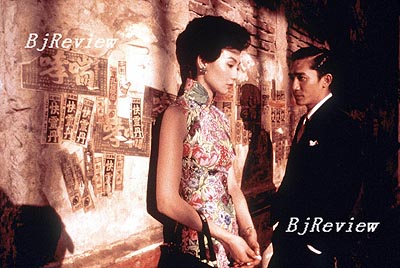|

A slim, stylish woman, ink black hair perfectly waved, takes a lonely walk on a humid evening in the city of Hong Kong in the 1960s. She's dressed in a traditional Chinese qipao and a wistful jazz melody follows her steps. This classic scene from Director Wong Kar-wai's Cannes-winning film In the Mood for Love is deeply rooted in minds of all who have watched it.
And in the film, Hong Kong actress Maggie Cheung's luminous screen appearances in over 20 styles of traditional qipao embodied the timeless beauty of China's most well known female garment.
When the qipao ruled
Made traditionally of Chinese silk or brocade, the qipao represents all that is beautiful in Chinese women.
The neck of the qiapo is high with the collar closed, and its sleeves may either be short, medium or full length depending on season and taste. The one-piece long dress is buttoned on the right side, with a loose chest, a fitted waist, and slit on both sides, all of which combine to perfectly enhance the female form.
This traditional Chinese dress was developed from the robes of Manchus in the Qing Dynasty (1644-1912). But what we talk about here is the modern or reformative qipao, which came into being in the early 1920s and then became popular in the 1930s and 1940s, spreading from Shanghai, where it originated, to other regions across the country.
The reformed style of the qipao absorbed the three-dimensional tailoring method of the West and added one-piece dress and evening wear elements in design, giving a new life to the ancient clothes. The loose robes belonging to nomadic ethnic groups evolved into a fashion statement of the highest order.
Many female movie stars in China in those years would appear on the covers of fashion magazines in a variety of qipaos. A slender qipao, deeply waved hair, silk stockings, high-heeled shoes, necklace, earrings and handbag were what the best-dressed women stepped out in.
"Not only misses or madams in rich families, almost all women in different age groups wore a qipao, including girls in primary schools and female workers from the spinning mills," said Jin Taijun, born in Shanghai in the 1930s, son and successor of Shanghai's 90-year-old Hongxiang Fashion Co. "The qipaos at that time were made of various materials, including silk, damask, cotton or leather," he added.
At wedding ceremonies, brides from affluent families would change their qipaos several times, Jin remembers. "When I got married, my wife wore four differently styled qipaos, besides two other wedding dresses," he said.
While the qipao brings its fine cut to endow a woman with added elegance, it also presents the wearer with certain requirements. Not only does her figure need to be slim, but the woman also needs a gentle temperament and a suitable environment to wear a qipao.
Struggling into the present
Jin also stresses that the qipao must be fully hand-tailored. According to him, there are 36 positions of the body that need to be measured to make a fitted qipao. The qipao's fasteners numbered in the hundreds of styles in the past.
However, with the development of modern garment manufacturing and the fast pace of modern life, the traditional tailoring skills needed to make qipao have all but disappeared, said Jin. "Nowadays few qipaos that are worn are made in the traditional way," he said.
Jin is pleased that after the screening of In the Mood for Love, in 2000, the qipao made a marked comeback. Qipao shops, large and small, have been mushrooming across China. And inspired by the qipao, many fashion designers-both Chinese and foreign-have been launching works blending Eastern and Western styles. Many world leading fashion brands, such as Christian Dior, Versace and Ralph Lauren, have also incorporated elements of the qipao in their latest designs.
The qipao has again been one of the choices, among various evening dresses, for Chinese women to attend formal social occasions. China's top film actresses, such as Gong Li and Zhang Ziyi, are firm advocates of the dress and their voluptuous form is often seen adorned by a qipao at international film festivals.
However in the life of the 9-to-5 city women on urban streets, the qipao appears inappropriate.
|